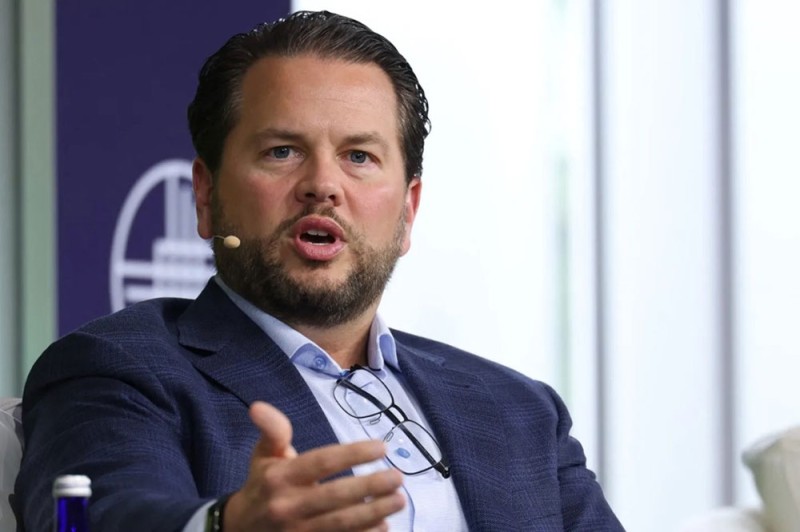
• Pinterest首席执行官比尔·雷迪做出一项备受争议的决策——关闭16岁以下用户的社交功能,此举致使公司股价暴跌26%,彼时华尔街预测该举措会削弱平台对Z世代的吸引力。然而,这一举措却为Pinterest带来利好,原因是如今Z世代在其用户群体中占比超40%,还将该平台视为“远离毒性的一片净土”。
三年前,Pinterest首席执行官比尔·雷迪做出令华尔街不满的决策:将用户长期福祉置于短期参与度指标之上,即使这意味着眼睁睁看着公司股价暴跌。
这一赌注已见成效。这家视觉发现平台如今拥有超5.7亿活跃用户,其中Z世代用户占比超40%——这是其规模最大且增长最快的用户群体。
自2022年6月雷迪接任首席执行官以来,Pinterest股价已飙升86%,不过相较于2021年2月新冠疫情期间创下的历史高点,仍下跌58%。
雷迪在戛纳国际创意节接受《财富》杂志采访时表示:“积极向上的内容能带来可观的商业效益。我们能够凭借践行正确之事收获成功,这本质上关乎短期利益与长期利益的权衡。”
自接任Pinterest首席执行官以来,雷迪最具争议的举措发生在2023年,彼时Pinterest成为首个将16岁以下用户账户默认设为“仅私密可见”的主要平台,此举旨在防止网络陌生人搜索到年轻用户,同时对部分社交功能加以限制。
这一决定引发了投资者对用户参与度的担忧,导致股价在2023年4月14日至5月5日期间暴跌26%。
雷迪回忆道:“当我们宣布这一决定时,人们认为这会让我们失去Z世代用户,但一年后,我们的用户量近乎翻番,因为这正是我们赢得Z世代用户的关键。”
雷迪的这种略显反主流的策略,映射出他更为宏大的理念:平台能够通过关注用户健康而非一味追求用户使用时长来实现蓬勃发展。
与其他社交媒体公司优化算法以展示最能激起强烈反应的内容不同,Pinterest重新设计了人工智能系统,优先推送用户有意识选择再次浏览的内容,而非仅能短暂吸引眼球的内容。
雷迪解释道:“社交媒体变得充满‘毒性’,根源在于其展示逻辑从按时间顺序呈现朋友发布的内容,转变为展示人工智能判定你该看到的内容。”
他说:“人工智能发现你会在那些能引发情绪波动的内容上停留更久。于是我们(科技行业)开始调整算法,力求最大限度延长用户的观看时长,使得平台优先推送那些能引发情绪波动的内容。”
如今,Pinterest的算法契合了雷迪所说的“有意识的选择与无意识的选择”。
雷迪用司机放慢车速围观车祸现场作比:人们可能会瞥一眼那些令人不安的内容,但实际上并不想再多看。“如果事后问他们‘还想再看一次吗?’绝大多数人会说‘不,那太可怕了。’”
Pinterest吸引Z世代用户
这一策略尤其能引起Z世代用户的共鸣。
“若你询问一位Z世代用户‘为何使用Pinterest’,他们定会提及两点,”雷迪说道,“其一,‘Pinterest真的懂我’;另一个至关重要的原因是,他们将Pinterest视作远离其他网络平台毒性内容的一片净土。”
“宣称我们应致力于用户的长期健康本不该引发争议。但我试图证明的是,积极向上的内容能带来可观的商业效益。”
除隐私设置外,Pinterest迅速将青少年聚焦计划拓展到更多领域。
Pinterest会在学校上课时段向学龄用户弹出提示信息,鼓励他们在课后使用,不过用户可选择忽略并跳过这一提示。
公司还倡导校园推行无手机政策,并与大西洋两岸的政界人士和监管机构合作。
“你必须有信念和勇气说,‘我相信这是正确的’”
雷迪承认,做出那些起初令投资者不满的决策会带来压力。
“你必须有信念和勇气说,‘不,我坚信这是正确的抉择,[并且]我会矢志不渝地坚持下去,’”他说,“但与此同时,你必须取得成果。”
对Pinterest而言,这些成果验证了雷迪的长期主义策略。
该平台达成了雷迪所说的“消费者应用中极为罕见的成就”:通过成功吸引年轻用户,“用户结构实现年轻化突破”——扭转了此前用户年龄不断增长且流失的趋势。
在广告行业低迷时期,该公司的成功使其在经济不确定性持续存在的情况下,有能力抢占市场份额。
雷迪谈及Z世代用户时表示:“我打赌,如果我们给他们提供一个替代方案,他们会欣然接受。幸运的是,这一策略奏效了。” (*)
译者:中慧言-王芳
• Pinterest首席执行官比尔·雷迪做出一项备受争议的决策——关闭16岁以下用户的社交功能,此举致使公司股价暴跌26%,彼时华尔街预测该举措会削弱平台对Z世代的吸引力。然而,这一举措却为Pinterest带来利好,原因是如今Z世代在其用户群体中占比超40%,还将该平台视为“远离毒性的一片净土”。
三年前,Pinterest首席执行官比尔·雷迪做出令华尔街不满的决策:将用户长期福祉置于短期参与度指标之上,即使这意味着眼睁睁看着公司股价暴跌。
这一赌注已见成效。这家视觉发现平台如今拥有超5.7亿活跃用户,其中Z世代用户占比超40%——这是其规模最大且增长最快的用户群体。
自2022年6月雷迪接任首席执行官以来,Pinterest股价已飙升86%,不过相较于2021年2月新冠疫情期间创下的历史高点,仍下跌58%。
雷迪在戛纳国际创意节接受《财富》杂志采访时表示:“积极向上的内容能带来可观的商业效益。我们能够凭借践行正确之事收获成功,这本质上关乎短期利益与长期利益的权衡。”
自接任Pinterest首席执行官以来,雷迪最具争议的举措发生在2023年,彼时Pinterest成为首个将16岁以下用户账户默认设为“仅私密可见”的主要平台,此举旨在防止网络陌生人搜索到年轻用户,同时对部分社交功能加以限制。
这一决定引发了投资者对用户参与度的担忧,导致股价在2023年4月14日至5月5日期间暴跌26%。
雷迪回忆道:“当我们宣布这一决定时,人们认为这会让我们失去Z世代用户,但一年后,我们的用户量近乎翻番,因为这正是我们赢得Z世代用户的关键。”
雷迪的这种略显反主流的策略,映射出他更为宏大的理念:平台能够通过关注用户健康而非一味追求用户使用时长来实现蓬勃发展。
与其他社交媒体公司优化算法以展示最能激起强烈反应的内容不同,Pinterest重新设计了人工智能系统,优先推送用户有意识选择再次浏览的内容,而非仅能短暂吸引眼球的内容。
雷迪解释道:“社交媒体变得充满‘毒性’,根源在于其展示逻辑从按时间顺序呈现朋友发布的内容,转变为展示人工智能判定你该看到的内容。”
他说:“人工智能发现你会在那些能引发情绪波动的内容上停留更久。于是我们(科技行业)开始调整算法,力求最大限度延长用户的观看时长,使得平台优先推送那些能引发情绪波动的内容。”
如今,Pinterest的算法契合了雷迪所说的“有意识的选择与无意识的选择”。
雷迪用司机放慢车速围观车祸现场作比:人们可能会瞥一眼那些令人不安的内容,但实际上并不想再多看。“如果事后问他们‘还想再看一次吗?’绝大多数人会说‘不,那太可怕了。’”
Pinterest吸引Z世代用户
这一策略尤其能引起Z世代用户的共鸣。
“若你询问一位Z世代用户‘为何使用Pinterest’,他们定会提及两点,”雷迪说道,“其一,‘Pinterest真的懂我’;另一个至关重要的原因是,他们将Pinterest视作远离其他网络平台毒性内容的一片净土。”
“宣称我们应致力于用户的长期健康本不该引发争议。但我试图证明的是,积极向上的内容能带来可观的商业效益。”
除隐私设置外,Pinterest迅速将青少年聚焦计划拓展到更多领域。
Pinterest会在学校上课时段向学龄用户弹出提示信息,鼓励他们在课后使用,不过用户可选择忽略并跳过这一提示。
公司还倡导校园推行无手机政策,并与大西洋两岸的政界人士和监管机构合作。
“你必须有信念和勇气说,‘我相信这是正确的’”
雷迪承认,做出那些起初令投资者不满的决策会带来压力。
“你必须有信念和勇气说,‘不,我坚信这是正确的抉择,[并且]我会矢志不渝地坚持下去,’”他说,“但与此同时,你必须取得成果。”
对Pinterest而言,这些成果验证了雷迪的长期主义策略。
该平台达成了雷迪所说的“消费者应用中极为罕见的成就”:通过成功吸引年轻用户,“用户结构实现年轻化突破”——扭转了此前用户年龄不断增长且流失的趋势。
在广告行业低迷时期,该公司的成功使其在经济不确定性持续存在的情况下,有能力抢占市场份额。
雷迪谈及Z世代用户时表示:“我打赌,如果我们给他们提供一个替代方案,他们会欣然接受。幸运的是,这一策略奏效了。” (*)
译者:中慧言-王芳
• Pinterest CEO Bill Ready made the controversial decision to turn off social features for users under 16, causing the stock to drop 26% as Wall Street predicted it would kill the platform’s appeal for Gen Z. Instead, the move helped Pinterest, with Gen Z now representing over 40% of its user base who view the platform as “an oasis away from toxicity.”
Pinterest CEO Bill Ready made a decision three years ago that Wall Street didn’t like: He would prioritize the long-term well-being of users over short-term engagement metrics, even if it meant watching the company’s stock price tumble.
The gamble has paid off. The visual discovery platform now boasts more than 570 million active users, with Generation Z representing over 40% of its user base—its largest and fastest-growing demographic.
Pinterest’s stock price today is up 86% from when Ready took over as CEO in June 2022, although it remains 58% down from its all-time high amid the COVID pandemic in February 2021.
“There’s a good business in positivity,” Ready told Fortune in an interview at Cannes Lions. “We can do well by doing good, and it really is about short-term versus long-term.”
After taking the reins at Pinterest, Ready’s most controversial move came in 2023, when Pinterest became the first major platform to make accounts for users under age 16 private-only by default, preventing young users from being discoverable to strangers online and restricting certain social features.
The decision triggered immediate backlash from investors concerned about user engagement, with the stock price plunging 26% between April 14 and May 5, 2023.
“When we announced that, people thought it would be our death with Gen Z,” Ready recalled. “But a year later we had nearly doubled because it was core to why we won with Gen Z.”
Ready’s somewhat contrarian approach reflects his broader philosophy that platforms can thrive by focusing on user health rather than maximizing screen time.
Unlike other social media companies that optimize algorithms to show users content that triggers the strongest reactions, Pinterest redesigned its artificial intelligence to prioritize what users consciously choose to see again, not just what captures their attention momentarily.
“Social media became toxic when it switched from being a chronological feed of what your friends posted to what the AI thought you should see,” Ready explained.
“The AI figured out you look longer at the things that trigger you,” he said. “We [the tech industry] started tuning for maximizing view time with the same triggering content rising to the top.”
Pinterest’s algorithm now appeals to what Ready calls “conscious choice versus unconscious choice.”
Using the metaphor of drivers slowing down to look at car accidents, Ready noted that while people may glance at disturbing content, they don’t actually want to see more of it. “If you ask somebody afterwards, ‘Would you like to see another one?’ The vast majority of people say, ‘No, that was terrible.’”
Pinterest capturing Gen Z
The strategy has resonated particularly well with Gen Z users.
“If you ask a Gen Z user, ‘Why do you go to Pinterest?’ there’s two things they’ll reliably tell you,” Ready said. “The first, ‘Pinterest just gets me.’ But the other really big part is they see Pinterest as an oasis away from the toxicity they experience elsewhere online.
“It shouldn’t be controversial to say that we should be committed to the long-term health of our users. But what I’m trying to prove is that there’s a good business in positivity.”
The company has quickly extended its youth-focused initiatives beyond privacy settings.
Pinterest shows pop-up messages to school-age users during school hours, encouraging them to return after classes, although this prompt can be ignored and bypassed.
It has also advocated for phone-free schools while working with politicians and regulators on both sides of the Atlantic.
‘You’ve got to have the conviction and the courage to say, “I believe this is right”’
Ready acknowledges the pressure that comes with making decisions that initially displease investors.
“You’ve got to have the conviction and the courage to say, ‘No, I believe this is right, [and] I’m going to see it through,’” he said. “But you also have to deliver results.”
For Pinterest, those results have validated Ready’s long-term approach.
The platform has achieved what Ready calls “something that is extremely rare amongst consumer apps”: It is “actually aging down” by successfully attracting younger users, reversing a previous trend of aging up and out.
The company’s success during the advertising industry downturn has positioned it to take market share as economic uncertainty continues.
“My bet was that if we give them an alternative, they’re going to choose it,” Ready said of Gen Z users. “Fortunately, that’s worked out for us.”

